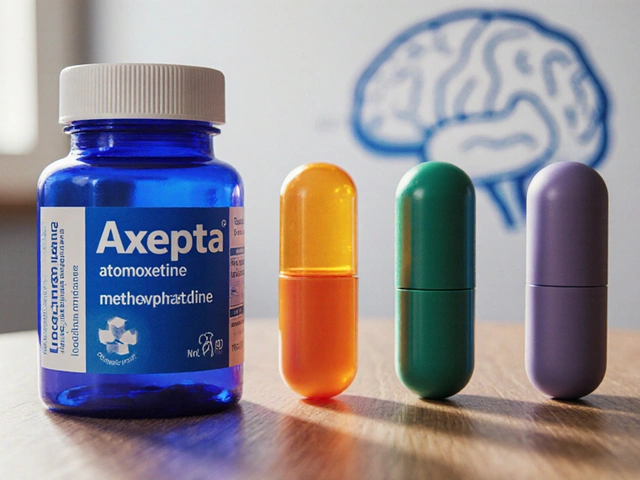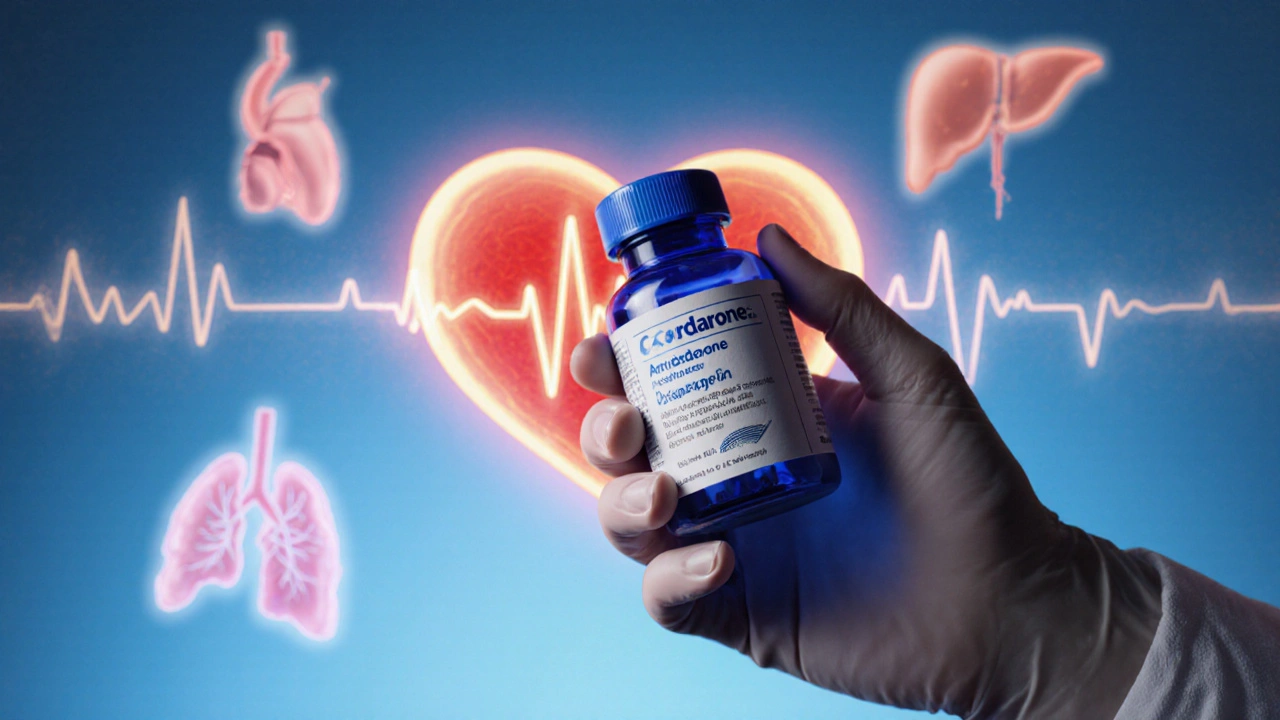When doctors need to control irregular heartbeats, Amiodarone a classIII anti‑arrhythmic medication sold under the brand name Cordarone often tops the list. It works powerfully but brings a laundry list of side effects, so clinicians frequently weigh other options. This guide breaks down how Amiodarone stacks up against the most common alternatives, helping patients and providers see which drug fits a given situation.
Key Takeaways
- Amiodarone is extremely effective for both atrial and ventricular arrhythmias but has a long half‑life and many organ‑specific toxicities.
- Sotalol offers dual beta‑blocker and classIII action with a shorter half‑life, making it easier to manage dosing.
- Flecainide and Propafenone (classIC) work best for patients without structural heart disease.
- Dronedarone is a safer, shorter‑acting analogue of Amiodarone, suitable for non‑heart‑failure atrial fibrillation.
- Choice depends on rhythm type, underlying heart condition, renal function, and how closely a patient can be monitored.
How Amiodarone Works
Amiodarone blocks potassium channels (classIII), slows conduction, and also has beta‑blocking, calcium‑blocking, and sodium‑blocking properties. This broad‑spectrum action makes it a “one‑size‑fits‑all” for many tough arrhythmias, from ventricular tachycardia to persistent atrial fibrillation. However, its lipophilic nature leads to tissue accumulation, resulting in a half‑life up to 100days. The drug can affect the thyroid, lungs, liver, eyes, and skin, demanding regular blood tests and imaging.
Major Alternatives
Sotalol a classIII anti‑arrhythmic that also blocks beta‑adrenergic receptors is often chosen for patients who need rhythm control without the extensive organ toxicity of Amiodarone. It’s cleared renally, so dose adjustments are required in kidney disease.
Flecainide a classIC sodium‑channel blocker works quickly to terminate supraventricular tachycardias but must be avoided in structural heart disease or coronary artery disease because of pro‑arrhythmic risk.
Propafenone another classIC agent with mild beta‑blocking activity shares Flecainide’s efficacy and restrictions, offering an oral option for “pill‑in‑the‑pocket” conversion of atrial fibrillation.
Dronedarone a non‑iodinated analogue of Amiodarone with a shorter half‑life reduces the risk of thyroid and lung toxicity, making it a better fit for patients without heart failure who need chronic rhythm control.
Dofetilide a pure classIII potassium‑channel blocker cleared by the kidneys is effective for persistent atrial fibrillation but requires inpatient initiation and continuous QT monitoring.
Ibutilide a classIII drug given intravenously for acute conversion of atrial fibrillation works fast but carries a high torsades de pointes risk, so it’s reserved for hospital settings.
Atrial fibrillation the most common sustained cardiac arrhythmia, often managed with anti‑arrhythmic drugs serves as the clinical backdrop for most of these medication choices.
Side‑Effect Profiles at a Glance
| Drug | Class | Typical Dose | Half‑Life | Key Side Effects | Best For |
|---|---|---|---|---|---|
| Amiodarone | III (multi‑channel) | 200mg‑400mg daily (loading), then 100mg | 30‑100days | Thyroid dysfunction, pulmonary fibrosis, liver enzymes, photosensitivity, corneal deposits | Life‑threatening ventricular arrhythmias, refractory AF |
| Sotalol | III+beta‑blocker | 80‑160mg twice daily | 12‑30hours | Pro‑arrhythmia (QT prolongation), renal impairment | Paroxysmal AF in patients with normal LV function |
| Flecainide | IC | 100‑300mg daily | 12‑27hours | Pro‑arrhythmia in CAD, dizziness | Patients without structural heart disease, “pill‑in‑the‑pocket” |
| Propafenone | IC | 150‑300mg daily | 10‑20hours | Metallic taste, beta‑blockade effects, pro‑arrhythmia | Similar to Flecainide, but with added beta‑block |
| Dronedarone | III (non‑iodinated) | 400mg twice daily | 13‑30hours | Gastro‑intestinal upset, liver enzymes, bradycardia | AF without heart failure or significant LV hypertrophy |
| Dofetilide | III | 125‑500µg twice daily (in‑patient) | 8‑10hours | QT prolongation, torsades, renal dosing | Persistent AF in patients with preserved EF |
| Ibutilide | III (IV) | 1mg over 10min, repeat once | 2‑5hours | Torsades, hypokalemia, hypotension | Acute conversion of recent‑onset AF in hospital |
Choosing the Right Drug for Your Situation
There’s no universal answer; the decision hinges on four main factors:
- Type of arrhythmia - ventricular tachycardia often forces a clinician toward Amiodarone, while isolated atrial fibrillation gives more leeway for safer agents.
- Underlying heart structure - any history of coronary artery disease or reduced ejection fraction steers away from classIC drugs.
- Organ function - renal insufficiency limits Sotalol, Dofetilide, and Ibutilide; liver disease cautions against Amiodarone.
- Monitoring capacity - drugs with QT‑prolonging risk (Sotalol, Dofetilide, Ibutilide) require frequent ECGs, often in a hospital.
Putting these together, a quick decision matrix looks like this:
- If you have a life‑threatening ventricular rhythm and can tolerate regular labs → Amiodarone.
- Recurring AF with normal LV function, willing to attend regular check‑ups → Sotalol.
- Paroxysmal AF, no structural disease, prefers oral “as‑needed” → Flecainide or Propafenone.
- AF, mild heart failure, wants fewer thyroid issues → Dronedarone (if LVEF>40%).
- Persistent AF, good renal function, can be monitored in‑patient → Dofetilide.
- Immediate cardioversion in the ER → Ibutilide.
Safety Monitoring and Practical Tips
Regardless of the chosen drug, regular follow‑up is non‑negotiable. Here’s a practical checklist:
- Baseline ECG, thyroid panel, liver enzymes, and chest X‑ray (for Amiodarone).
- Recheck labs every 3months for the first year, then every 6months.
- Educate patients about photosensitivity (Amiodarone) and to report new shortness of breath.
- Adjust doses for weight changes, pregnancy, or renal decline.
- Consider drug‑drug interactions - many anti‑arrhythmics affect CYP3A4, warfarin, and statins.
Frequently Asked Questions
Can I stop Amiodarone abruptly?
No. Because of its long half‑life, stopping suddenly can cause rebound arrhythmias. Tapering under cardiologist supervision is recommended.
Is Dronedarone safe for people with heart failure?
Dronedarone is contraindicated in patients with NYHA classIII/IV heart failure or a recent hospitalization for decompensation. In such cases, Amiodarone or a beta‑blocker‑based strategy is preferred.
Why does Amiodarone cause thyroid problems?
The drug contains a large amount of iodine, which disrupts normal thyroid hormone synthesis. Both hypo‑ and hyper‑thyroidism can appear months after starting therapy.
What monitoring is required for Sotalol?
Baseline ECG, renal function test, and periodic QT interval checks are essential. Dose reduction is needed if creatinine clearance falls below 50mL/min.
Can Flecainide be used after a heart attack?
No. Post‑myocardial infarction patients have scar tissue that raises the risk of pro‑arrhythmic events with classIC drugs. Alternative agents like Amiodarone or beta‑blockers are safer.
Bottom Line
In short, Amiodarone remains the most potent option but its side‑effect profile often pushes clinicians toward alternatives that better match a patient’s specific heart condition and monitoring capacity. By weighing rhythm type, structural heart disease, organ function, and follow‑up feasibility, you can pick the anti‑arrhythmic that offers the right balance of effectiveness and safety.




Comments
18 Comments
Sayam Masood
When you weigh a drug that can sit in your tissues for months, you’re really juggling a marathon against a sprint-efficacy versus toxicity. Amiodarone wins the sprint, but the marathon of follow‑up labs can exhaust both patient and provider.
Jason Montgomery
Great rundown, especially the tip about baseline thyroid panels; keeping an eye on those labs early makes the whole process feel less like a gamble and more like a team sport.
Wade Developer
From a pharmacodynamic perspective, the multi‑channel blockade of amiodarone confers a unique anti‑arrhythmic breadth, yet its pharmacokinetic profile-particularly the 30‑ to 100‑day half‑life-necessitates a longitudinal risk‑benefit calculus that surpasses the immediacy of agents such as sotalol or flecainide.
rama andika
Ah yes, another “miracle” pill that lets pharma keep their profit margins while we wait three months for a side‑effect to finally show up-because who doesn’t love a good plot twist in their medication list?
Kenny ANTOINE-EDOUARD
Amiodarone's efficacy in both ventricular and atrial arrhythmias makes it a first‑line consideration for many electrophysiologists.
The drug's ability to block potassium, sodium, calcium, and beta‑adrenergic channels creates a broad anti‑arrhythmic effect that few other agents can match.
However, that same breadth translates into a cascade of off‑target effects that demand vigilant monitoring.
Thyroid dysfunction is perhaps the most common endocrine issue, stemming from the high iodine content of the molecule.
Pulmonary toxicity, though less frequent, can be severe and is often misattributed to infection if clinicians are not vigilant.
Hepatic enzyme elevations are another signal that the drug is not being metabolized cleanly, and they may herald more serious liver injury.
Dermatologic photosensitivity is a quirky side‑effect that can be mitigated by simple sun protection measures, yet patients often forget to apply sunscreen daily.
Ophthalmic micro‑deposits are usually benign, but they illustrate how the drug distributes to virtually every tissue.
From a dosing standpoint, the loading phase of 200‑400 mg daily can quickly saturate tissue stores, which is why a gradual taper to 100 mg is recommended for maintenance.
Renal function does not significantly alter amiodarone clearance, but hepatic impairment can prolong its already extensive half‑life.
Because the half‑life can exceed 100 days, any decision to discontinue the drug should be made with a clear tapering plan to avoid rebound arrhythmias.
In patients with heart failure, amiodarone remains one of the few agents that can be used safely, unlike class IC drugs that are contraindicated.
When comparing to sotalol, consider that sotalol's renal clearance makes dose adjustments essential in chronic kidney disease, whereas amiodarone is less sensitive to renal changes.
Finally, the cost of regular laboratory tests, imaging, and specialist visits can offset the drug's price advantage, so insurance coverage and patient adherence become practical concerns.
In summary, the choice between amiodarone and its alternatives hinges on a balance of arrhythmia control, organ‑specific risk tolerance, and the healthcare system's capacity to sustain long‑term monitoring.
Tracy Winn
Honestly, the table looks decent but could use a bit more color to keep my eyeballs awake.
Jessica Wheeler
It feels ethically questionable to prescribe a drug that can scar the lungs or thyroid without first exhausting safer alternatives; patients deserve a treatment plan that respects their long‑term wellbeing.
Mikayla Blum
Reading through the side‑effect list feels like scrolling a horror novel, yet the promise of rhythm control keeps the plot moving forward :)
Jo D
Sure, the “standard of care” loves amiodarone, but everyone knows the real gold standard is a treadmill test, a C‑MRI, and a crystal ball to predict who will survive the next QT spike.
Sinead McArdle
Appreciate the concise matrix; it provides a quick reference without overwhelming the reader.
Katherine Krucker Merkle
The practical checklist at the end is spot on-especially the reminder about photosensitivity, which many patients overlook.
Mark Quintana
Im wonderin if theres any new data on combining low dose amio with sotalol for pts who cant tolerat high dosees?
Brandon Cassidy
That summary nicely ties the pharmacology back to patient selection; well done.
Michelle Guatato
Don’t be fooled by the glossy brochures; the real agenda is keeping us hooked on a drug that guarantees a steady stream of lab work for the profit‑driven labs. Every ECG, thyroid test, and chest X‑ray is a reminder that the system is more interested in recurring revenue than in truly curing the arrhythmia. The “shorter‑acting” analogues are just marketing tricks to push the next generation of patented molecules. Remember, the fewer side‑effects you experience, the less likely you are to question the prescriber's motives. Stay vigilant.
Gabrielle Vézina
While the guide is thorough it overstates amiodarone’s uniqueness; many class III agents share similar efficacy.
carl wadsworth
Listen up: if you’re going to start a patient on amiodarone, set up a strict monitoring schedule from day one-labs every month, ECGs bi‑weekly for the first three months, and a chest X‑ray at six months. Skipping any of those checkpoints is reckless and puts the patient at unnecessary risk. Make the protocol crystal clear in the electronic health record so no one can claim ignorance.
Neeraj Agarwal
Just a heads‑up: “half‑life” should be hyphenated and “thyroidal” is the correct adjective, not “thyroid”.
Rose K. Young
Skipping the monitoring plan? That’s just plain negligent.
Write a comment